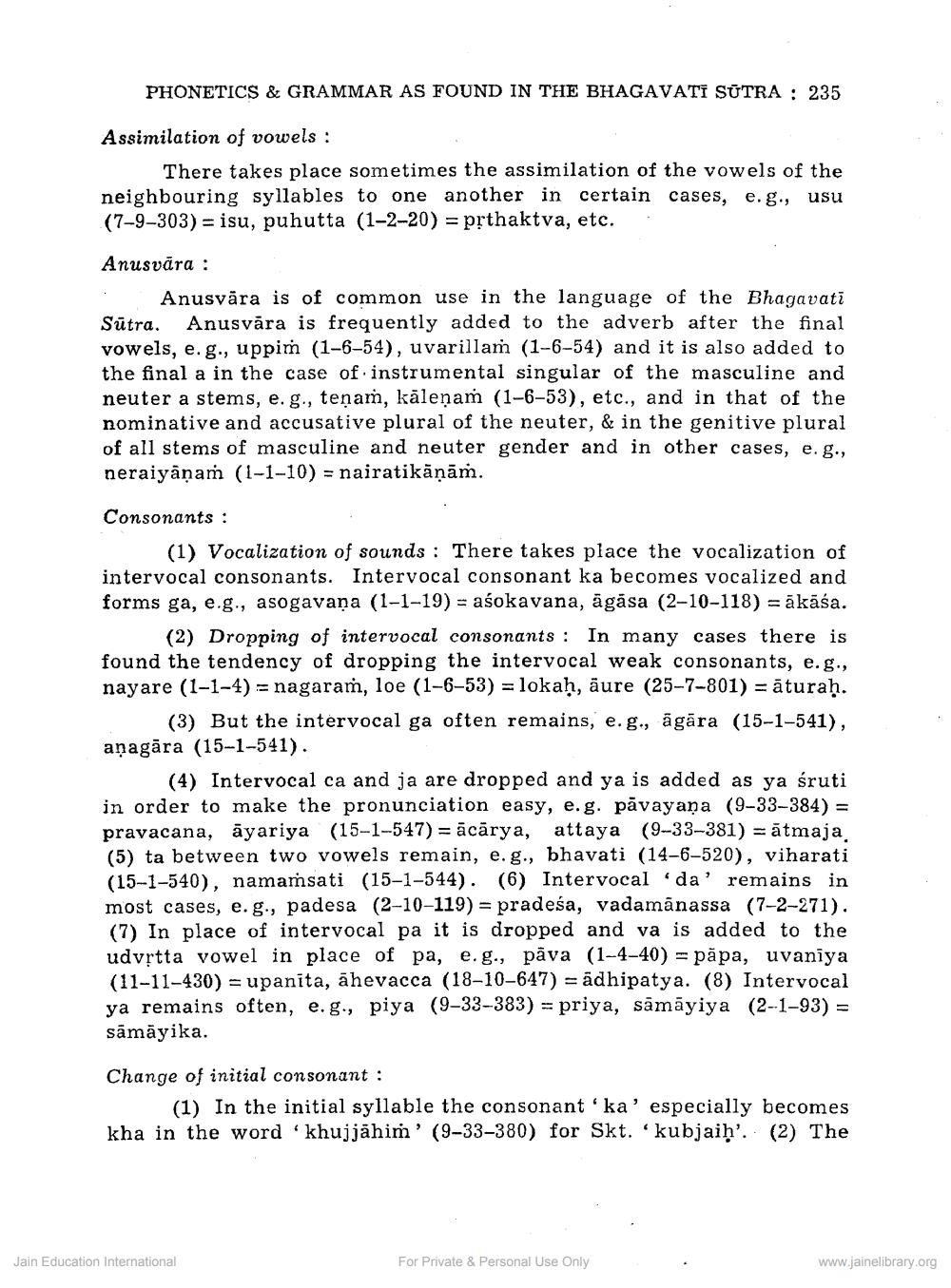Book Title: Brief Survey of Phonetics and Grammar as Found)in the Bhagawati Sutra Author(s): J C Sikdar Publisher: Z_Mahavir_Jain_Vidyalay_Suvarna_Mahotsav_Granth_Part_1_012002.pdf and Mahavir_Jain_Vidyalay_Suvarna_ View full book textPage 3
________________ PHONETICS & GRAMMAR AS FOUND IN THE BHAGAVATI SŪTRA: 235 Assimilation of vowels: There takes place sometimes the assimilation of the vowels of the neighbouring syllables to one another in certain cases, e. g., usu (7-9-303) isu, puhutta (1-2-20) = pṛthaktva, etc. Anuspara: Anusvāra is of common use in the language of the Bhagavati Sútra. Anusvāra is frequently added to the adverb after the final vowels, e. g., uppim (1-6-54), uvarillam (1-6-54) and it is also added to the final a in the case of instrumental singular of the masculine and neuter a stems, e. g., tenam, kaleņam (1-6-53), etc., and in that of the nominative and accusative plural of the neuter, & in the genitive plural of all stems of masculine and neuter gender and in other cases, e. g., neraiyaṇam (1-1-10)= nairatikāṇāṁ. Consonants: (1) Vocalization of sounds: There takes place the vocalization of intervocal consonants. Intervocal consonant ka becomes vocalized and forms ga, e.g., asogavana (1-1-19) aśokavana, āgāsa (2-10-118) = ākāśa. (2) Dropping of intervocal consonants: In many cases there is found the tendency of dropping the intervocal weak consonants, e.g., nayare (1-1-4)= nagaram, loe (1-6-53) lokaḥ, äure (25-7-801) = aturaḥ. (3) But the intervocal ga often remains, e.g., āgāra (15-1-541), aṇagāra (15-1-541). (4) Intervocal ca and ja are dropped and ya is added as ya śruti in order to make the pronunciation easy, e.g. påvayapa (9-33-384) = pravacana, ayariya (15-1-547) äcârya, attaya (9-33-381) atmaja, (5) ta between two vowels remain, e. g., bhavati (14-6-520), viharati (15-1-540), namamsati (15-1-544). (6) Intervocal da' remains in most cases, e. g., padesa (2-10-119) pradeśa, vadamānassa (7-2-271). (7) In place of intervocal pa it is dropped and va is added to the udvṛtta vowel in place of pa, e. g., pāva (1-4-40) păpa, uvaniya (11-11-430) upanīta, ähevacca (18-10-647) adhipatya. (8) Intervocal ya remains often, e. g., piya (9-33-383) = priya, sāmāyiya (2-1-93)= sāmāyika. Change of initial consonant: (1) In the initial syllable the consonant 'ka' especially becomes kha in the word 'khujjahim' (9-33-380) for Skt. kubjaiḥ'. (2) The Jain Education International For Private & Personal Use Only www.jainelibrary.orgPage Navigation
1 2 3 4 5 6 7 8 9
